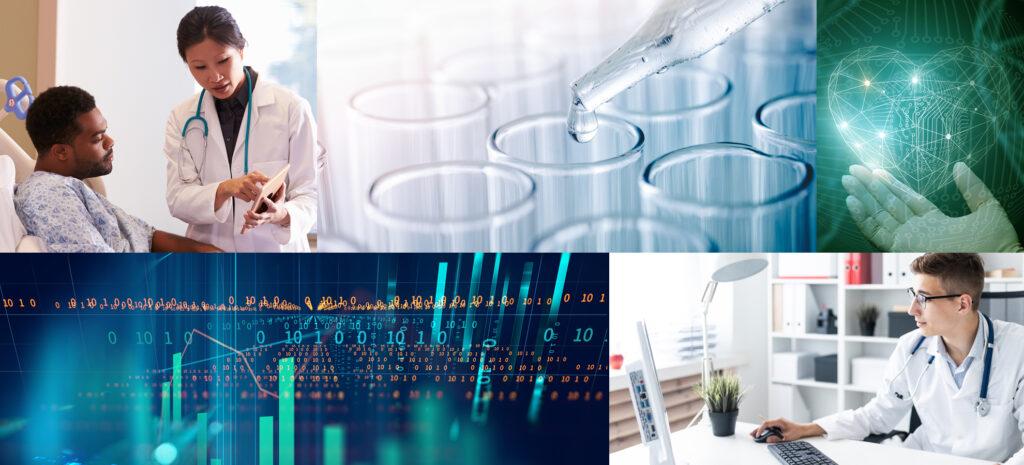The biopharma space is constantly evolving, and right now, a concept in the spotlight is targeted therapy and cancer treatment. Different types of cancer therapy target breast cancer, lung cancer, pancreatic cancer, and other forms. Some of the biggest biopharma deals of the last few years centered around targeted cancer treatments. How does targeted therapy work, and what does it mean for the industry and patient outcomes in the field of medical oncology?
In this post, we’ll cover the basics of targeted therapy, how it compares to other types of treatment (e.g., radiation therapy and chemotherapy), the development process, and where technology fits in.
What is targeted therapy?
Targeted therapy is a type of cancer treatment that attacks cancer cells. Two of the most common types of targeted treatments are small-molecule drugs and monoclonal antibodies. Small-molecule drugs enter cells easily and are used as targets inside cells. Monoclonal antibodies are proteins produced in the lab. These proteins attach to specific targets on cancer cells.
How does targeted therapy compare to chemotherapy?
Both of these approaches are cancer treatments. That said, targeted therapy is a more specific treatment than chemotherapy, which means it can be more effective in targeting cancer cells and have fewer toxic side effects. In 2006, the percentage of US cancer patients estimated to benefit from genome-targeted therapy was just 0.07%. By 2018, the percentage was 4.9%.
As technology continues to support the development of these treatments, more patients will likely select and benefit from targeted therapies. However, this doesn’t mean that targeted therapy and chemotherapy are mutually exclusive. Every patient is different and may use one or both types of treatment.
Since targeted therapies are more specific to a person’s disease, they can be used as a first-line treatment for certain cancers. For this reason, chemotherapy and targeted treatments are also often used in combination to treat cancer.
To understand how targeted therapy differs from precision therapy, read the post “What is precision medicine?”
How can pharma companies develop new targeted therapies?
To create targeted therapies, researchers conduct research to identify a target and develop a drug treatment that attacks it. Targeted drug therapies can do different things to the cancerous cells they target:
- Block or turn off signals that tell cancer cells to grow and divide
- Prevent further cancer cell growth
- Destroy cancer cells
Pharmaceutical companies can also use advanced imaging data to understand the cancer genome’s biology better. Some use artificial intelligence (AI) algorithms and machine learning to uncover new drug targets. This presents new challenges, as companies have to put new processes in place to organize and manage large amounts of data.
An insights management platform can also accommodate insight-gathering activities that help research and development teams working on targeted therapies. This helps organizations better understand the disease community and patients more effectively and efficiently.
Overview of the targeted therapy development process
The benefits of exploring and creating targeted therapies are clear, but how does it all work? Developing a targeted therapy can be broken down into four primary phases. Here’s a closer look at each one.
- Phase 1: First, researchers work to identify the specific genetic changes associated with cancer. This is the drug’s target. Ideally, they are looking for a protein in cancer cells but not in a person’s healthy cells. From here, they can work on developing the treatment for those cancer cells.
- Phase 2: After the treatment is developed, this phase is usually conducted on small groups of people with the same type of cancer. This phase aims to determine the safety, tolerability, and impacts of using the drug.
- Phase 3: This phase involves seeing how the treatment works. Drug developers will want to see if it has any side effects that could be harmful and how it interacts with other medications a person may be taking. It also helps researchers learn more about a cancer type. This way, they can better understand what causes it or why some people don’t respond to traditional treatments.
- Phase 4: This phase will test whether the treatment works better than standard methods for treating cancer by comparing its effectiveness against placeboes, existing therapies, and other interventions. This is a critical step to determine if the treatment should be recommended to patients and to find opportunities for improvement.
For example, when the target changes, cancer cells can become resistant to targeted therapy. This can also happen when cancer cells find new ways to grow that don’t depend on the target of that specific treatment.
The future of targeted therapy and technology
Agility is a critical element of the precision oncology space, especially as pharmaceutical companies gain more access to patient data and other information that contributes to better treatments. However, many considerations come with speeding up the process in a strategic way. Pharmaceutical companies must consider whether they:
- Can easily engage experts and patients worldwide without traditional participation barriers like extensive travel or language differences
- Have a way to understand disease communities, including which experts are most critical
- Extract information from online conversations about current therapies, patient experience, scientific information, and other essential exchanges
- Can be more efficient while also being compliant
The importance of precision therapy to cancer treatment cannot be overstated, and as demand for these treatments increases, pharmaceutical companies must ensure they are adopting processes to support demand.
Want to learn more about how early insights managed with the help of purpose-built tech can add agility at the pre-clinical stage? Read “The priciest pre-clinical study? The one you do twice.”






